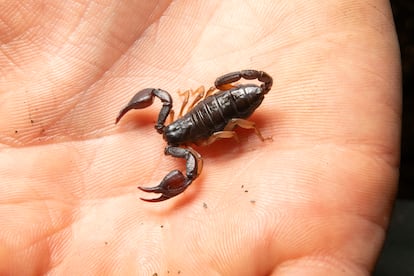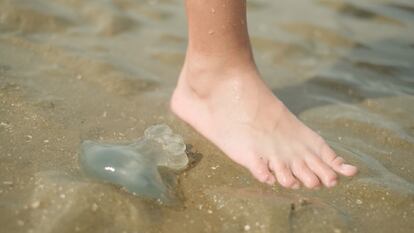Myths and truths about poisonous bites and stings: how often they occur and what to do

It happened like this: his hand resting on the grass, an almost imperceptible prick, and the viper, coiled around itself, ready to defend itself again. It was a late August afternoon, cool enough for Guzmán López (Burgos, 28) to go jogging through Fuentes Blancas Park, in his hometown. He took his usual route and, halfway there, sat down to rest under a tree. That's when the viper bit him . "At first, I wasn't sure if it had hit me or not. I stared at my finger for a long time until I noticed the two marks," the young man recalls ten years after the incident.
Guzmán did what many would do in these cases, which is precisely what one shouldn't do. "At the time, I thought of Frank de la Jungla and tried to suck the venom out and spit it out, but it didn't work." Then he tied a tourniquet around his finger and ran for about fifteen minutes to the emergency room. "When I arrived, they removed it, and my entire arm felt like a sausage." The doctors asked him if he knew what type of viper had bitten him. "I wasn't in a condition to analyze it," he replied. He later learned it had been a viper ( Vipera latastei ), one of the five species of venomous snakes that live in the Iberian Peninsula. In the end, the scare was just that, a scare. Guzmán spent a couple of days under observation, and when his arm went down, they let him go home. They didn't even need to inject him with antivenom.
This young man from Burgos's experience is one of those rare, but potentially dangerous, encounters between humans and snakes. A survey that compiled data from the Health Information Institute between 1997 and 2020 found that during those years there were 560 bites in Spain, and only one was fatal. However, there could be more: up to half of viper attacks do not inject venom, so people don't show any symptoms and end up not going to the hospital. They are called "dry bites" and tend to remain under the official radar.
The summer months tend to be the months with the greatest exposure. "Not because snakes are more active, but because people are," explains Fernando Martínez Freiría, a herpetologist and researcher at the Spanish Herpetological Association. During the good weather, outdoor activities are more frequent, and this leads to more chance encounters with "medically relevant" animals, that is, venomous ones. These include, in addition to snakes, scorpions, spiders, bees or wasps, fire ants ( newly invasive in Spain), and jellyfish, all well-known to coastal vacationers.
Mild or anecdotal casesTheir occurrence is rare, perhaps why venomous bites and stings, regardless of the animal, are so mythologized. Everyone knows someone who supposedly suffered from them. "But the prevalence of dangerous cases is very low, only 1.23 occur per million inhabitants. Most do not require intensive treatment, not even hospitalization," explains Fernando Cortés Fossati, a researcher in the Biodiversity and Conservation Department at Rey Juan Carlos University.
In many cases, as the Ministry of Health warns , the incidents cause immediate pain, edema, and localized swelling, which disappears within a few days. Furthermore, depending on the species, the toxins cause vomiting, severe abdominal pain, diarrhea, and difficulty breathing and swallowing. Some symptoms may be due to fear rather than the venom itself, such as nausea, rapid heartbeat, or restlessness. Children and the elderly are the ones who should be most alert to reactions to the venom. "The rest are usually anecdotal cases," says Cortés.

Most bites or stings are accidental . “Sometimes they occur because people put their hand under a rock, or because a child runs barefoot through an area with scorpions,” Cortés points out. In the case of spiders, many are so small that they don't even have the mechanical strength to pierce human skin. And 99% of species are harmless. There have been no cases of deaths associated with arthropods in Spain in recent years, at least according to the most recent data, which indicates 59 bites recorded in 17 years. Cortés explains this by assuring them that they are not aggressive animals: “If there is a bite, it's because someone sits on a blanket where a spider is hiding, squashes it, and it reacts.”
The same goes for snakes, adds Martínez, which only bite when someone tries to handle them or steps on them. “No snake chases humans, not even the most venomous in the world. They shy away from contact because they know they're losing,” he says. If you encounter one, the most sensible thing to do is simply move away and let it go. If it bites someone, don't try to suck the venom out with your mouth because it can re-enter the body through the mucous membrane or a wound.
Katherine Isoardi , president of the Australasian Poison and Toxicology Network, points out that applying a tourniquet isn't helpful either, as toxins can accumulate in the area and cause further damage. The best option is to stay still and calm (fast movements increase blood circulation, which distributes the poison more quickly throughout the body) and call 911. Applying an antidote is usually not necessary.
Isoardi points out that "immobilization is best for certain spider and snake bites." And for the pain, taking a strong painkiller is enough.
Bad ideasLiving with scorpions doesn't seem complicated either. There were 46 recorded stings between 1997 and 2020, and no fatal cases. But some myths also surround them. The most widespread, explains Cortés, is that when they sting , you should cut the wound to squeeze out the venom. "All of this usually makes the situation worse. The best thing to do is to remain calm, not overreact, and go to a medical center," she adds.

Hymenoptera, such as bees and wasps , can pose a problem, as their stings can produce anaphylactic shock, an allergic reaction so severe it can kill if medical attention is not received. Of the 373 Hymenoptera stings recorded in the country in nearly two decades, 13 were fatal.
Killing the animal that caused the damage, in addition to being irresponsible for personal safety, is, in the case of snakes, a crime, since virtually all species are listed in the Spanish Catalogue of Endangered Species and subject to special protection. "There are still people who try to catch the snake after being bitten, which is a terrible idea. Trying to capture a snake in general is a very bad idea," Isoardi points out.
At the same time, both Martínez and Cortés insist that these living beings "perform essential ecological functions," such as regulating pests. And that, despite their bad reputation, they are essential for the survival of ecosystems.
Toxins also in the seaJellyfish are every vacationer's nightmare. However, their serious encounters with humans are also rare. Cortés, who is currently writing a study on severe poisonings in Spain by toxic marine animals, has found that there are only 50 recorded cases requiring hospital care between 1997 and 2022, and no deaths. Another fact: between 2016 and 2022, only one of those recorded required intensive care.
But if you are unlucky enough to be stung by a jellyfish , the Ministry of Health recommends washing the affected area without rubbing and always using salt water, either from the sea itself or a saline solution. Fresh water is the worst enemy in these cases, since due to the difference in osmotic pressure, the remains of stinging cells left on the skin could explode and spread more venom. They also recommend removing any remaining tentacles attached to the wound with tweezers or a similar object (never with your hands), applying indirect cold, and avoiding exposure to sunlight. If, after doing all this, the condition worsens, you should seek medical attention.
EL PAÍS





